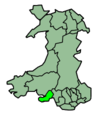Mumbles (district)
Mumbles is a district of Swansea, Wales located on the south east corner of the unitary authority area. It is also a local government community of the same name. At the 2001 census the population was 16,774, reducing slightly to 16,600 at the 2011 Census. The district is named after the headland of Mumbles which is located on the southeast corner of the district.
The Mumbles
| |
|---|---|
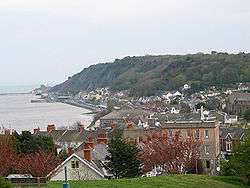 Mumbles viewed from Oystermouth castle | |
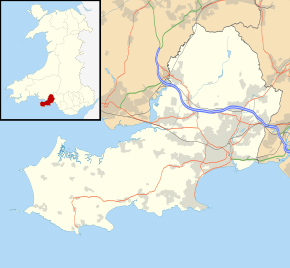 The Mumbles Location within Swansea | |
| Population | 16,600 (2011 census)[1] |
| Principal area | |
| Ceremonial county | |
| Country | Wales |
| Sovereign state | United Kingdom |
| Post town | SWANSEA |
| Postcode district | SA3 |
| Dialling code | 01792 |
| Police | South Wales |
| Fire | Mid and West Wales |
| Ambulance | Welsh |
| UK Parliament | |
| Senedd Cymru – Welsh Parliament |
|
History
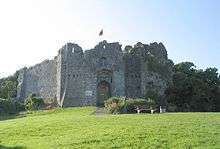
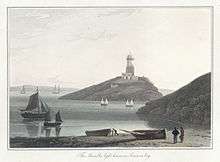
.jpg)
Archaeological evidence indicates that an ancient submerged forest was located on what is now the foreshore of Mumbles Bay The bones of bears, wolves, hyenas, deer, rhinoceros and mammoth have been discovered there. A bone cave at the western tip of Caswell Bay was excavated in 1832 but has since been destroyed by the sea. Another cave, at the Inner Sound, Mumbles Head, was blown up by quarrymen in 1838 but not before elephant bones had been found. Also scattered around the bays of Mumbles and Gower are the bones of sixteen Ice Age mammals, including a mammoth tooth measuring ten centimetres across, which is on display in Swansea Museum.
The first human crop growers arrived in the area over 5,000 years ago.[2] However, evidence of human habitation is much older and possibly dates as far back as 30,000 years ago—established by the dating of the famous Paviland skeleton located in a cave some 10–15 miles along the coast from Mumbles Head.[3] The skeleton is kept in the Oxford Museum of Natural History, having been excavated by Rev William Buckland, who was Professor of Geology at Oxford University at the time. However, Swansea Museum has two well-finished flint axe-heads, one from Newton and one from an allotment on Mumbles Hill. Much of what we know about the first metalworkers, in the Bronze Age, has been learned from their tombs: pieces of pottery, a cairn and remains of a hut were found. The cliffs above the Redcliffe flats at Caswell Bay contain the ridged remnants of a Redley Cliff Iron Age hill-fort.
There is evidence that the Romans were based in Mumbles in a villa on the site of the present All Saints Church in Oystermouth. When the site was being extended in 1860, workmen removing a bank of earth on the south side of the original building accidentally broke up a Roman tessellated pavement, or mosaic floor. This was previously a pagan site, as were many sites of worship in the UK which subsequently became places of worship at the onset of Christianity. In this area it has been reported that Romano British gentlemen of Roman Wales may have eaten oysters from the oysterbeds off the shore below the site at Oystermouth, or Ystumllwynarth. The Norman Castle at Oystermouth was built during the first half of the 12th century - one of many castles built in Gower as a defense against the native Welsh Princes who sought to re-claim the lands stolen by the Norman invaders. [the Royal Commission on Ancient & Historical Monuments in Wales, Glamorgan, The Early Castles, London, HMSO, 1991]. The architectural merits of the church, castle and other buildings in Oystermouth are discussed in J.Newman, The Buildings of Wales: Glamorgan, London, Penguin/University of Wales Press, 1995.
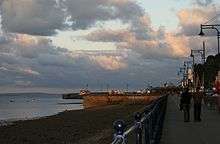
Three of the bells in All Saints Church once belonged to the Jesuit church of La Compañía ("The Company") in Santiago, Chile. They seem to have been brought to Mumbles by Aubrey Vivian after the fire of 1863 burnt down the Jesuit church, killing 2,000 people. The family of industrialist Henry Vivian had business connections with the copper mines of Chile.
In 1793, the Mumbles Lighthouse was erected on the outer of the two tidal islands of Mumbles Head.[4] In 1806, the Oystermouth Railway was built between Oystermouth and Swansea with the intention of carrying coal to Swansea. The potential for carrying passengers was soon seen and a horse-drawn railway passenger service was started on 25 March 1807, making it the first such service in the world. It became enormously popular and was commonly called 'the Mumbles train'. Following the development of the rail service, Mumbles became a popular tourist destination. To capitalise on this, the Mumbles railway was extended and a pier was constructed and opened in 1898 to serve as the new terminus. An RNLI lifeboat slipway was added to the pier in the summer of 1916 and a boathouse was finally built on it in 1922; these remain in use. [Needs updating as there is a new boathouse].
On 23 April 1947, the Mumbles lifeboat lost a crew of eight men while attempting to rescue the crew of the Samtampa that had run aground on Sker Point. The Mumbles railway was closed in January 1960 and dismantled - a controversial decision that still resonates in the locality (calls to "bring back the Mumbles train" are still frequently heard and printed in local newspapers).
Soon after it was built in 1898, the end of the Mumbles Pier became home to Bandstand Concerts and on the landward side was a Winter Garden both of which attracted large crowds. It was advertised by the Swansea and Mumbles Railway as 'The Prettiest Pier in the Bristol Channel' and the 'Mumbles Press' on 13 April 1911, featured the Skating Rinks as well as Hanney's Select Military Band. In the 1950s, a large entertainment center on the end of the Pier included 'Dodgems' Coconut Shies and other fairground attractions. Near the bridge to the lifeboat, two Amusement Kiosks survived from Edwardian days. The landward side of the Pier had a Cafe, with a 'Penny Slot Arcade' alongside and a popular Dance Hall was part of the 'Pier Hotel.' The amusement complex was redeveloped at the land end of the Mumbles Pier in 1966 and this proved to be a profitable attraction to visitors, resulting in the addition of a new building containing an amusement arcade, restaurant and bowling alley.
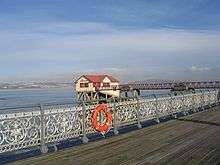
The 'Mumbles Mile' is a stretch of road in Mumbles once notable for its concentration of pubs. It has long been a popular destination for pub crawls and binge drinking. Famous poet Dylan Thomas was said to have enjoyed many hours at The Mermaid. The 'Mumbles Mile' began to decline in popularity during the 1990s because of pressure from the local council and increased competition from Swansea's night attractions. Now, there are only five pubs on the 'mile', whereas there were once upwards of 20.
The Encyclopedia of Wales says that Mumbles has always been considered a place apart... as the verse puts it:
- Mumbles is a funny place,
- A church without a steeple,
- Houses made of old ships wrecked
- And most peculiar people.[4]
The origin of the name "Mumbles" is obscure. Wyn Owen and Morgan (2008) cite several possibilities: Middle English momele ("to mumble"), describing the "mumbling" of the sea next to the rocks; Latin mamillae meaning "breasts", in reference to the breast shaped silhouette of the islands and headland, and Old Norse múli (snout, promontory).[5]
The 2004 mini-series Mine All Mine, starring Griff Rhys Jones, was filmed in Mumbles.
Local government
Mumbles was part of Oystermouth Urban District established in 1894,[6] which was merged with the County Borough of Swansea in 1918.[7] The Mumbles is in the Oystermouth electoral ward, while the current Mumbles community also includes the surrounding electoral wards of Mayals, Newton and West Cross.
Notable people
- Rowan Williams, Archbishop of Canterbury, was brought up in the area
- Richard Valentine Pitchford (aka Cardini), Master Magician, was born in Mumbles in 1895.
- Catherine Zeta-Jones, actress, grew up in Mumbles from the age of 12, and she and Michael Douglas have a house there
- Ian Hislop, satirist and editor, was born in Mumbles.
- Joanna Page, actress, was born in Treboeth Swansea
- Bonnie Tyler, singer and songwriter, lives in Mumbles.
- Bishop Graham Charles Chadwick, anti-apartheid campaigner, served in curacy at All Saints Church and is buried in Oystermouth Cemetery.
- Thomas Bowdler, who with Henrietta Maria Bowdler edited Shakespeare, is buried in Oystermouth.
- Jean Jenkins, an Australian senator (1987–1990), was brought up in Mumbles,
- Mal Pope, musician and composer, lives in Mumbles
- Andy Secombe, voice actor, actor and novelist, was born in Mumbles
- Melanie Walters, actress (Gavin & Stacey), lives in Mumbles
- Alan Curtis, former Wales international footballer, lives in Mumbles
- Robert Pugh, actor, lives in Mumbles
- Alun Wyn Jones, captain of the Wales national rugby union team grew up in the area
- William Hughes, boxer and child actor (Doctor Who), was born in Mumbles.
- Hannah Stone, Royal Harpist, grew up in Mumbles
Settlements
The villages in the community council region are:
- Blackpill
- Mayals
- Langland
- Limeslade
- Newton
- Norton
- Oystermouth
- Thistleboon
- West Cross
Twinning
The Mumbles community is twinned with :
Further reading
- The Mixture: Mumbles and Harry Libby, Harry Libby, c.1957 (self published by the author, Trebellan, Southend, Mumbles)
- The Mumbles - Past and Present, Norman L. Thomas, 1978, ISBN 0906199026
- A Childhood in Mumbles & Gower, Freda Marrison, 1995 (The Cottle Printing Company, Oystermouth, Gower)
- Once Upon A Village, Aspects of Life in Mumbles 1901-1914, Carol Powell, 1996 (Inalong Publishing, Mayals, Swansea)
- Images of Wales: Mumbles and Gower Pubs, Brian E. Davies, 2008, ISBN 9780752437798
References
- "District population 2011". Retrieved 13 April 2015.
- Williams, Moelwyn (1975). The Making of the South Wales Landscape. London: Hodder & Stoughton.
- Cunliffe, Barry (2012). Britain Begins. Oxford: Oxford University Press. ISBN 978-0199609338.
- The Welsh Academy Encyclopedia of Wales. Cardiff: University of Wales Press 2008
- Wyn Owen, H. and Morgan, R. (2008) Dictionary of the Place-names of Wales. Llandysul: Gomer.
- West Glamorgan Archive Service, Oystermouth Urban District Council Records
- Oystermouth Urban District Council - City and County of Swansea
- https://www.baltimoresun.com/maryland/harford/aegis/ph-ag-hdg-twinning-mumbles-0206-story.html
